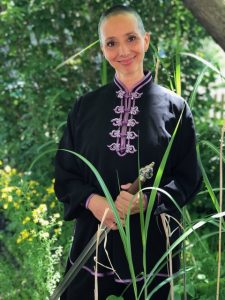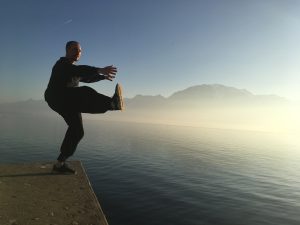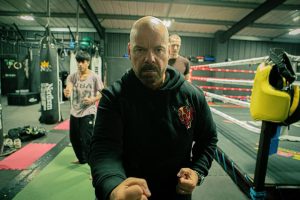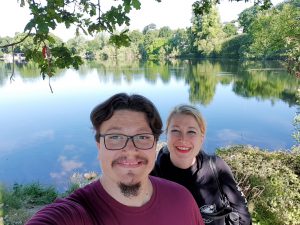Here is some more detail from your teachers about the topics they will be presenting at the weekend
Gordon Faulkner
1. Daoyin Stress Prevention
2. Daoyin Stress Relief
3. Wudang Taiji Sword Techniques
4. Taiji Qinna
Yanira Rodriguez 
1. Yang Chengfu’s 10 important points
The “ten essential points” (十要 shí yào) of Tàijíquán 太極拳 are a series of key principles for the practice of this art. They were dictated orally by master Yáng Chéngfǔ 楊澄甫 and recorded by his disciple Chén Wēimíng 陳微明 through a brief formula of a few characters followed by an explanation or commentary.
Each of these points constitutes an essential principle of the practice, their correct understanding determines the ability to experience harmony and balance during the practice of Taiji.
2. Harmonizing and increasing Qi circulation
The first section of the Yang Stlyle Baduanjin is a simple routine that can be practiced on its own, as part of a warm-up or training.
By learning these movements, we develop awareness through the coordination of movements on the one hand and on the other hand we will mobilize Qi through breathing in order to unblock areas of inflammation, pain, or tightness.
3. 5 elements: control and dominance cycles in push hands.
The structure of the 5 elements, their interactions and balance applied in the field of push hands. In this 45-minute session we will have the opportunity to learn how they work and how to use them in the context of push hands practice.
4. Wu Duan Jin.
Before starting our Qigong or Tàijí practice we need to prepare ourselves globally with a general mobilization of the body and in harmony with the principles of Qigong and Tàijí. This routine is one of the best routines for this as it prepares the physical structure and internal state through joint range of motion and muscle preparation, intrinsic energy generation, dynamic alignment and continuity between yin and yang.
Paul Silfverstrale 
Total Body Force
Coordination and awareness in solo & partner work.
Loading the Gun
Power generation and execution of power in applications.
Dao 1 – Sabre basics: understanding your tool
Body work, solo, partner drills and applications.
Dao 2 – Sabre basics: understanding your tool
Body work, solo, partner drills and applications – builds upon the Dao 1 session progressively.
Tammy Bliss 
Harmonizing Mind, Body, and Qi:
An Integrated Qigong and Meditation Practice This practice combines two powerful techniques – Shi Er Duan Jin (Twelve Golden Treasures) and Ma Wang Dui Dao Yin Shu – to cultivate internal Qi, balance energy meridians, and achieve mental clarity.
Understanding Qi and Health
In TCM, many health issues stem from imbalances or blockages in our vital energy (Qi). By cultivating and directing Qi through mindful movement and breath, we can address these underlying causes and promote overall well-being.
Part 1: Shi Er Duan Jin – The Twelve Golden Treasures
- This ancient breathing technique, first described by Lao Tzu, focuses on stimulating Qi energy through coordinated breath, movement, and intention.
Key principles:
- Synchronize mind, breath, and gentle movements
- Alternate between movement and stillness
- Perform soft, natural, and smooth motions
- Massage internal organs while stretching ligaments and tendons
Practice:
- Focus on deep, diaphragmatic breathing
- Slowly move through the 14 postures, coordinating breath with each movement
- Maintain awareness of Qi flow throughout the body
Part 2: Ma Wang Dui Dao Yin Shu – Meridian Channel Cultivation
- This practice aligns specific movements with energy meridians to strengthen the body and nourish the heart.
Key principles:
- Coordinate slow, gentle movements with breath and intention
- Alternate between opening/closing, ascending/descending, and rotating/revolving
- Focus on the beginning and ending points of each meridian
Practice:
- Learn the forms associated with each meridian
- Move through the sequences, visualizing Qi flowing along the corresponding channels
- Maintain a balance between movement and stillness
Integrating the Practices
By combining these techniques, we cultivate stillness, mental clarity, and a deeper connection between breath and movement.
- Begin with Shi Er Duan Jin to stimulate overall Qi flow
- Transition to Ma Wang Dui Dao Yin Shu for targeted meridian work
- Conclude with a period of silent meditation, focusing on the interaction of Spirit (Shen) and Qi
Remember: “When spirit moves, Qi moves. Where spirit ceases, Qi ceases.” Cultivate this mutual interaction for enhanced vitality and longevity. Practice regularly, with patience and intention, to experience the full benefits of this integrated Qigong and meditation approach.
Mauro Bertoli
“Ba Men” the 8 doors: study of the fundamental forces of Taijiquan
The study of the fundamental forces of Taijiquan forms one of the central themes of the learning method in most traditional schools of Taijiquan.
Over the weekend we will work on the four main “gates”: Peng, Lu, Ji, An. We will analyze the four main forces according to Sifu Mauro Bertoli’s approach, looking for links between solo form and pair work.
Frederic Plewniak 
Fundamentals of sword manipulation
How to create and keep an efficient connection with your sword for effortless and fluid wielding of the weapon.
From Tuishou to Sword play
Taiji Principles as exercised in Tuishou also apply to Sword partner drills. We will study a few Tuishou drills and how they may be adapted to the Sword.
Harriet Devlin 
There is no beginning …..
Working with movement, allegory and Chinese philosophy this morning workshop will explore the theme of birth and awakening in the first sequence of the Yang Style Long Form
There is no end ….
Working with movement, allegory and Chinese philosophy this afternoon workshop will explore the theme of death and release in the last sequence of the Yang Style Long Form
Severin Berz 
A free Kwa as a prerequisite for central balance
The Dantien must be differentiated, free and connected with our shoulders and our Kwa to take advantage of its full potential. We will see what their relationships are, how to differentiate and connect them and why the Dantien can only truly serve as a central balance if the shoulder and pelvic girdle are free and flexible. We will do exercises alone and in pairs in order to regain the autonomy and collaboration of these body regions and to have a sharper awareness of them. We will also see these principles used in Tuishou and for martial application.
Perception as key to Push Hands
Our body is subject to our perception, which is intimately connected to the fascia. When the perceptual field is stiff, the body is also stiff at the subtle level. Therefore it is interesting to be more consciously in relationship of our field of perception and to learn to be able to influence our body and that of our partner through our perception.
James Carss 
1. The 8 standing postures of Han Xing Qiao
2. Yiquan Health Exercises
3. Xingyi Horse – technique and application
4. Pick the star – the baguazhang of the Han Family
Dee Swift 
Fixed Pattern flowing hands – exploring one fixed pattern push hands routine each day
Meditation to Six Directions Qigong
Opening the Joints – exercises to focus on freeing the joints to allow flow of Qi
Katrin Blumenberg
Qi Gong for Vitality
Let us circulate the Qi throughout the whole body. We will focus on the spine and the lower back to allow a smooth Qi flow.
Qi Gong to Purge and Detoxify
Easy, effective Qigong movement to rinse stagnation and toxins out of the body and the mind.
The movement can be applied as a complement to your Taichi practice as well as the everyday life.
Qi Gong for Protection
Being smooth and tender and at the same time having the ability to protect yourself. We will unite these supposed oppositions in Qigong movements.
Qi Gong to practice with your (grand)children
Qi Gong can be so much fun. Swinging your butt like a panda or using some magic as a fairy.
The exercises will give you the chance to experience lightness yourself and to introduce Qigong to your (grand)children.
Sergio Uzzo & Simona Longeri 
Body Mechanics – how to use the body to push or pull.
Body Mechanics – how to step
Copyright 2025 Tai Chi Caledonia | Privacy Policy

